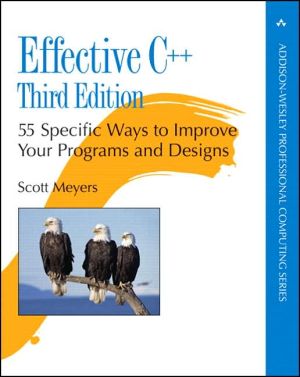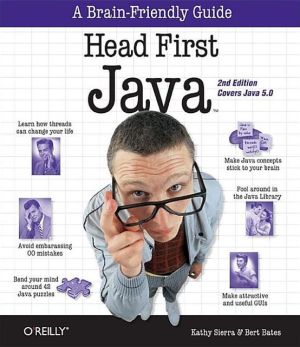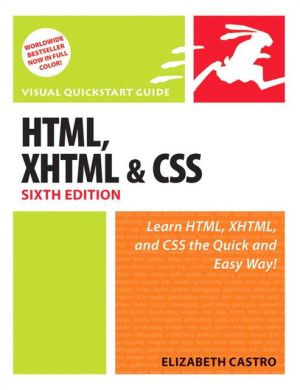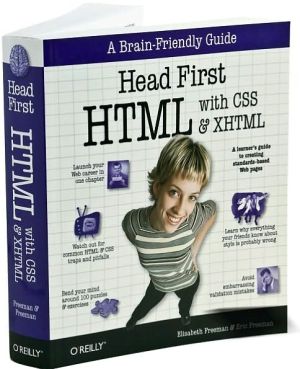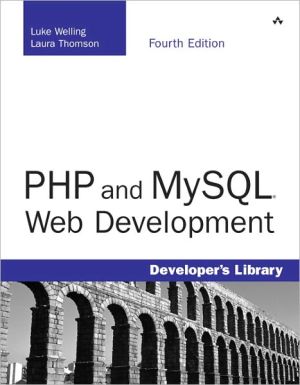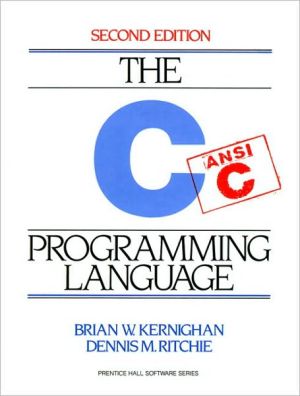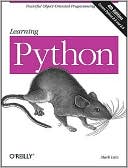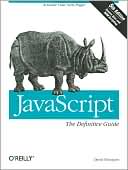Effective C++: 55 Specific Ways to Improve Your Programs and Designs
“Every C++ professional needs a copy of Effective C++. It is an absolute must-read for anyone thinking of doing serious C++ development. If you’ve never read Effective C++ and you think you know everything about C++, think again.”\ — Steve Schirripa, Software Engineer, Google\ “C++ and the C++ community have grown up in the last fifteen years, and the third edition of Effective C++ reflects this. The clear and precise style of the book is evidence of Scott’s deep insight and distinctive...
Search in google:
Meyers offers his insights on writing C++ software that is comprehensible, maintainable, portable, extensible, efficient, and likely to behave as expected. Topics of the 55 items include: declare destructors virtual in polymorphic base classes, copy all parts of an object, postpone variable definitions as long as possible, avoid hiding inherited names, and pay attention to compiler warnings. The third edition adds chapters on resource management and programming with templates. Annotation ©2005 Book News, Inc., Portland, OR Slashdot.org A major re-write and re-org. Do you need this book? If you program C++, yes, you probably do, even if you have a previous edition. Don't let the "Third Edition" faze you, because it has lots of new insights into the vagaries of the C++ language. And if you're new to C++, this is pretty much a must-own book.
I wrote the original edition of Effective C++ in 1991. When the time came for a second edition in 1997, I updated the material in important ways, but, because I didn’t want to confuse readers familiar with the first edition, I did my best to retain the existing structure: 48 of the original 50 Item titles remained essentially unchanged. If the book were a house, the second edition was the equivalent of freshening things up by replacing carpets, paint, and light fixtures.\ For the third edition, I tore the place down to the studs. (There were times I wished I’d gone all the way to the foundation.) The world of C++ has undergone enormous change since 1991, and the goal of this book — to identify the most important C++ programming guidelines in a small, readable package — was no longer served by the Items I’d established nearly 15 years earlier. In 1991, it was reasonable to assume that C++ programmers came from a C background. Now, programmers moving to C++ are just as likely to come from Java or C#. In 1991, inheritance and object-oriented programming were new to most programmers. Now they’re well-established concepts, and exceptions, templates, and generic programming are the areas where people need more guidance. In 1991, nobody had heard of design patterns. Now it’s hard to discuss software systems without referring to them. In 1991, work had just begun on a formal standard for C++. Now that standard is eight years old, and work has begun on the next version.\ To address these changes, I wiped the slate as clean as I could and asked myself, “What are the most important pieces of advice for practicing C++ programmers in 2005?” The result is the set of Items in this new edition. The book has new chapters on resource management and on programming with templates. In fact, template concerns are woven throughout the text, because they affect almost everything in C++. The book also includes new material on programming in the presence of exceptions, on applying design patterns, and on using the new TR1 library facilities. (TR1 is described in Item54.) It acknowledges that techniques and approaches that work well in single-threaded systems may not be appropriate in multithreaded systems. Well over half the material in the book is new. However, most of the fundamental information in the second edition continues to be important, so I found a way to retain it in one form or another. (You’ll find a mapping between the second and third edition Items in Appendix B.)\ I’ve worked hard to make this book as good as I can, but I have no illusions that it’s perfect. If you feel that some of the Items in this book are inappropriate as general advice; that there is a better way to accomplish a task examined in the book; or that one or more of the technical discussions is unclear, incomplete, or misleading, please tell me. If you find an error of any kind — technical, grammatical, typographical, whatever — please tell me that, too. I’ll gladly add to the acknowledgments in later printings the name of the first person to bring each problem to my attention.\ Even with the number of Items expanded to 55, the set of guidelines in this book is far from exhaustive. But coming up with good rules — ones that apply to almost all applications almost all the time — is harder than it might seem. If you have suggestions for additional guidelines, I would be delighted to hear about them.\ I maintain a list of changes to this book since its first printing, including bug fixes, clarifications, and technical updates. The list is available at the Effective C++ Errata web page, http://aristeia.com/BookErrata/ec++3e-errata.html. If you’d like to be notified when I update the list, I encourage you to join my mailing list. I use it to make announcements likely to interest people who follow my professional work. For details, consult http://aristeia.com/MailingList/.\ Scott Douglas Meyers Stafford, Oregon April 2005\ http://aristeia.com/
Preface xvAcknowledgments xviiIntroduction 1Chapter 1: Accustoming Yourself to C++ 11Item 1: View C++ as a federation of languages. 11Item 2: Prefer consts, enums, and inlines to #defines. 13Item 3: Use const whenever possible. 17Item 4: Make sure that objects are initialized before they’re used. 26Chapter 2: Constructors, Destructors, and Assignment Operators 34Item 5: Know what functions C++ silently writes and calls. 34Item 6: Explicitly disallow the use of compiler-generated functions you do not want. 37Item 7: Declare destructors virtual in polymorphic base classes. 40Item 8: Prevent exceptions from leaving destructors. 44Item 9: Never call virtual functions during construction or destruction. 48Item 10: Have assignment operators return a reference to *this. 52Item 11: Handle assignment to self in operator=. 53Item 12: Copy all parts of an object. 57Chapter 3: Resource Management 61Item 13: Use objects to manage resources. 61Item 14: Think carefully about copying behavior in resource-managing classes. 66Item 15: Provide access to raw resources in resource-managing classes. 69Item 16: Use the same form in corresponding uses of new and delete. 73Item 17: Store newed objects in smart pointers in standalone statements. 75Chapter 4: Designs and Declarations 78Item 18: Make interfaces easy to use correctly and hard to use incorrectly. 78Item 19: Treat class design as type design. 84Item 20: Prefer pass-by-reference-to-const to pass-by-value. 86Item 21: Don’t try to return a reference when you must return an object. 90Item 22: Declare data members private. 94Item 23: Prefer non-member non-friend functions to member functions. 98Item 24: Declare non-member functions when type conversions should apply to all parameters. 102Item 25: Consider support for a non-throwing swap. 106Chapter 5: Implementations 113Item 26: Postpone variable definitions as long as possible. 113Item 27: Minimize casting. 116Item 28: Avoid returning “handles” to object internals. 123Item 29: Strive for exception-safe code. 127Item 30: Understand the ins and outs of inlining. 134Item 31: Minimize compilation dependencies between files. 140Chapter 6: Inheritance and Object-Oriented Design 149Item 32: Make sure public inheritance models “is-a.” 150Item 33: Avoid hiding inherited names. 156Item 34: Differentiate between inheritance of interface and inheritance of implementation. 161Item 35: Consider alternatives to virtual functions. 169Item 36: Never redefine an inherited non-virtual function. 178Item 37: Never redefine a function’s inherited default parameter value. 180Item 38: Model “has-a” or “is-implemented-in-terms-of” through composition. 184Item 39: Use private inheritance judiciously. 187Item 40: Use multiple inheritance judiciously. 192Chapter 7: Templates and Generic Programming 199Item 41: Understand implicit interfaces and compile-time polymorphism. 199Item 42: Understand the two meanings of typename. 203Item 43: Know how to access names in templatized base classes. 207Item 44: Factor parameter-independent code out of templates. 212Item 45: Use member function templates to accept “all compatible types.” 218Item 46: Define non-member functions inside templates when type conversions are desired. 222Item 47: Use traits classes for information about types. 226Item 48: Be aware of template metaprogramming. 233Chapter 8: Customizing new and delete 239Item 49: Understand the behavior of the new-handler. 240Item 50: Understand when it makes sense to replace new and delete. 247Item 51: Adhere to convention when writing new and delete. 252Item 52: Write placement delete if you write placement new. 256Chapter 9: Miscellany 262Item 53: Pay attention to compiler warnings. 262Item 54: Familiarize yourself with the standard library, including TR1. 263Item 55: Familiarize yourself with Boost. 269Appendix A: Beyond Effective C++ 273Appendix B: Item Mappings Between Second and Third Editions 277Index 280
\ From Barnes & NobleThe Barnes & Noble Review\ Since early in the ’90s, working C++ programmers have relied on Scott Meyers’s Effective C++ to dramatically improve their skills. But the state-of-the-art has moved forward dramatically since Meyers last updated this book in 1997. (For instance, there’s now STL. Design patterns. Even new functionality being added through TR1 and Boost.) So Meyers has done a top-to-bottom rewrite, identifying the 55 most valuable techniques you need now to be exceptionally effective with C++. \ Over half of this edition’s content is new. Templates broadly impact C++ development, and you’ll find them everywhere. There’s extensive coverage of multithreaded systems. There’s an entirely new chapter on resource management. You’ll find substantial new coverage of exceptions. Much is gained, but nothing’s lost: You’ll find the same depth of practical insight that first made Effective C++ a classic all those years ago. Bill Camarda, from the July 2005 Read Only\ \ \ \ \ \ Slashdot.orgA major re-write and re-org. Do you need this book? If you program C++, yes, you probably do, even if you have a previous edition. Don't let the "Third Edition" faze you, because it has lots of new insights into the vagaries of the C++ language. And if you're new to C++, this is pretty much a must-own book.\ \
